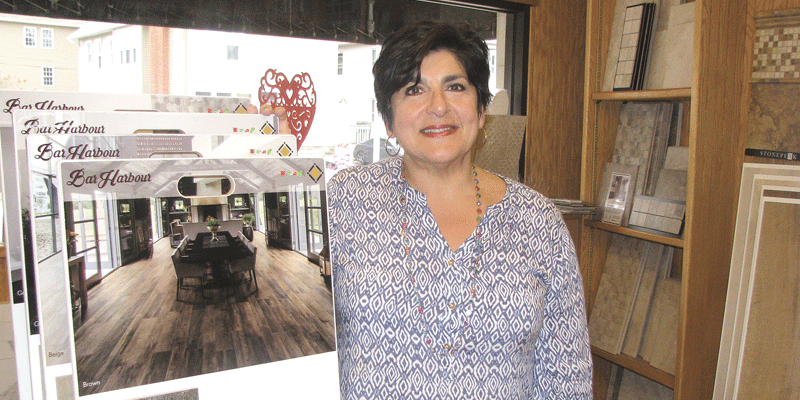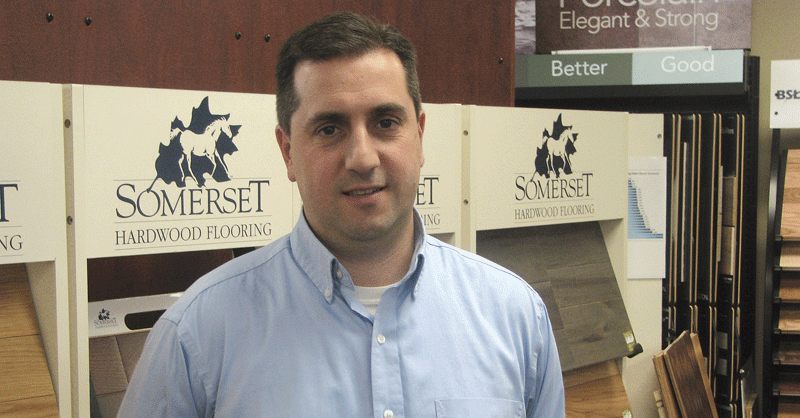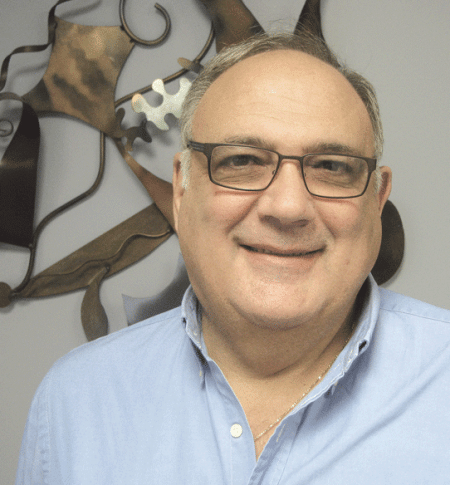Tastes Change Quickly in the World of Flooring
Fancy Footwork

Karen Tesini says customers are willing to pay for quality in a product they’ll have to live with for a long time.
Flooring products aren’t cheap, for the most part, which is why Best Tile recently opened an outlet store that caters to customers on a budget.
“We have a closeout outlet to stay in tune with people who don’t have the financial means to buy higher-end materials,” said Karen Tesini, manager of the Springfield-based store. But she found she doesn’t do nearly as much business there as she does in the main showroom. “Our customers are serious buyers; they know tile has longevity, it’s not something they’ll change frequently, and they’re willing to pay for high quality. That’s our typical client.”
Jorge Morgado agreed.
“The average person coming in, if they’re not looking to move often, if they’ll be staying in their home for a while, they’re really looking for better-quality materials, better-quality flooring,” said the vice president of Baystate Rug and Flooring in Chicopee and East Longmeadow. “People are still value-driven, but with the trend toward an improving economy — at least, there’s definite movement in that direction — they want something of quality.”
Steve Omartian knows something about quality. As the third-generation owner of Toros Omartian & Son, his family has been dealing in hand-woven, high-quality Oriental rugs — buying, selling, cleaning, repairing, and appraising them — for 96 years, and only in recent decades has he begun stocking rugs at price tags less than $5,000, to capture a segment of the market that prefers to stay around $3,000 or less.
“Professionals in the area were telling me, ‘I can’t afford your rug; it’s like $20,000, isn’t it? We could never afford a rug from you guys,’” he recalled, suggesting he had a perception problem more than a price problem. “The Omartian name had suggested very expensive rugs, but we were priced just like any other rug store. We do moderate to high-end rugs, we do collectibles — all the different designs and colors available in the oriental-rug industry now.”
What Tesini, Morgado, and Omartian have in common — besides businesses focused on floor coverings — is the need to strike a balance between quality, since customers will live with their products for a long time, and shoppers who focus on the bottom line. It’s not always an easy tradeoff.
“Obviously the economy — even though people say it’s thriving — is still soft in this area,” Morgado told BusinessWest, noting that his customer base has tended to skew older (typically professional people in their 40s and up) and it’s always a challenge to attract young people who are just as likely to grab a machine-manufactured rug on sale at Home Depot.
But if there’s one thing high-end and budget-conscious shoppers have in common, its that their tastes change — often quickly.
Broad Opinions
Indeed, Morgado said, “just like clothing trends, the style of hardwood flooring has changed over the years. In the past, he explained, hardwood options existed on a single continuum, dark finish to light finish, and three-inch planks were standard across the industry.
“Today’s look is completely different,” he went on. “People are looking for the wide boards, wide planks, with some character, whether it’s hand-scraped, darker-stained, whatever it takes to create that unique, different finish. These are considered higher-end products.”

Jorge Morgado says tastes in wood flooring have shifted in the past couple of years to wider planks and shades of gray.
He noted that proponents of wider planks feel they make a room feel more open and can create the appearance of a cleaner-looking space. Another rising trend is setting planks at a diagonal, rather than vertically or horizontally.
Morgado also noted that reclaimed wood is growing in popularity because it appeals to customers on two levels: eco-friendliness, and a vintage, one-of-a-kind look. This wood is being reused from sources such as barns, beams, wooden barrels, and salvaged logs, and the planks typically have characteristics that are different from board to board.
Finally, shades of gray are all the rage in hardwood flooring, rather than the natural finishes that have dominated for so long. One reason is that it tends to be a more neutral backdrop for paint, upholstery, and accessories. “People are attracted to that,” he said.
Tesini agreed, saying the gray craze has crossed over into tile as well. “A year and a half, maybe two years ago, the most popular color was beige. And, just overnight, a lightswitch was hit, and now everything is white and gray tile.”
Another consumer trend, Morgado said, is tile that looks like wood. At a time when designers are getting away from wood-colored cabinetry in favor of black and white, wood-colored flooring, if not hardwood itself, can be an attractive complement, since the rest of the space isn’t overwhelmed with wood. “More people are doing these uniquely finished things that are not considered traditional.”
Tesini said customers are responding to the sheer quality of tile that mimics wood. “Now, it’s digitally imaged, where before, it was screen printed. Digital imaging has come so far, and it’s difficult to tell it’s not real wood. Almost every manufacturer has changed their process to provide the highest-quality image on tile. It’s really an amazing time to be in the tile business.”
The other big trend in tile has to do with size, she told BusinessWest, with the long-popular 12-by-12 tiles being overshadowed today by 12-by-24 pieces. And that’s just the residential side. “Commercially, the bigger, the better: 16-by-32, 24-by-24.”
Changing Tastes
The biggest shift in the Oriental rug industry, Omartian recalled, was a change, in the early to mid-1980s, in how designs were created.
“In the interior-design field, American [wholesale] buyers would go to the countries of origin and buy what they made. But in the ’80s, they started telling them what to make, what designs and colors they wanted. And the market drastically changed — it became more appealing to the American consumer. It’s progressed that way ever since.”
That shift means Oriental rugs aren’t just an afterthought to a design, but are often included in a complete room strategy, just as fabrics, paint, wallpaper, and draperies are. “As far as the decision goes, it’s incorporated in the process, where, prior to the ’80s, it wasn’t.”

Steven Omartian says his company has stayed nimble in order to sell high-end rugs in an economy that has not fully recovered from the recession.
That was an overall positive to dealers like his family, but Omartian says the industry still faces plenty of challenges, including an economy that remains a bit soft. One change to compensate for fluctuating economy is an increased business presence; where his business was once 85% residential and 15% commercial, now it’s closer to 60-40. “We sell a lot for professional offices — an accent piece in the office or a large Oriental rug in the conference room, as well as occasionally hanging carpets on the wall as artwork.”
Morgado said manufacturers of wood flooring — and other materials, for that matter — produce lower-quality versions of their products to bring in value hunters and people who can’t afford high-end materials, but those who can afford top-line products demand them, if only because of how permanent those choices tend to be.
That said, while hardwood remains a popular choice, it typically trades places back and forth with carpeting in the race for most-popular floor covering.
“Designers know it’ll be a hardwood trend, then a carpet trend, then back to hardwood. The trend now is that carpet is starting to come back around. Designers are saying, ‘if you want a room to be comfortable, it’s a lot easier to bring comfort with a carpet,’” he explained, noting that today’s top-line rugs are built for both softness and better cleanability than before. He cited one brand in particular, Karastan, as the “Mercedes brand,” and noted that many people gravitate toward that as an alternative to wood.
While tile brands jostle for market dominance as well, Tesini said, she has seen a huge demand for Carrera tile — particularly in white and gray, of course — for kitchen floors, backsplashes, and bathrooms. But, she added, there will always be a place for natural stone.
“There’s an exotic quality to stone — it will always cost a bit more money than porcelain based on the rarity of certain types of stone, like marble,” she said, adding, however, that higher-end tiles are closing the price gap. “Natural stone is still very, very popular. Tile has come so far, but stone is stone; it’s what God created, and he’s not making it any better or worse. It’s never gone away in popularity.”
Which means it’s one more option for home and business owners looking to spend a little money — or a lot, as the case may be — for perhaps their most-used possession.
Joseph Bednar can be reached at [email protected]





